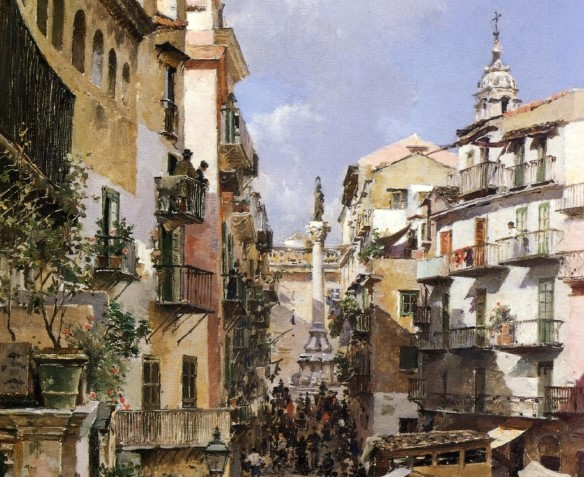The capital of the fiefdom
The original article was written in Italian: In viaggio attraverso il Feudo di Maria
English translation by L. Whitaker
We resume our journey through the fiefdom of
Mary in the former capital of the Kingdom of Sicily: Palermo.
Is there any chance that the fiefdom’s very
capital wouldn’t be replete with marvellous and ancient devotions,
demonstrating the love that the people of Palermo bear for their Queen?
Of course not!
Indeed, just like in Trapani, in this region
we faced a daunting task in attempting to select just a few of the many titles
by which the Virgin Mary has been venerated through the centuries.
The only thing we knew for certain was where
to start: it had to be what is, without a shadow of a doubt, the most important
Marian devotion in Palermo’s Christian tradition: the Immaculate Conception!
We all know, of course, that the veneration
of the Immaculate Virgin Mary is part of the common heritage of the Church and
all Catholic communities around the world; however, in Palermo it takes on a
very special character entirely of its own.
Just like in the rest of Sicily, veneration
of the Immaculate Madonna in the capital goes back a very long way; indeed,
traces of it can even be found several centuries before the proclamation of the
Dogma by the Church in 1854.
Such is the depth of the love and faith of
the people of Palermo for the Immaculate Virgin that when plague broke out in
1624, the city senate decided to entrust themselves to the intercession of the
Immaculate Madonna, as well as to Saint Rosalie.
And they did it in a truly commendable way:
on 15th August of that year, the Bishop of Palermo made a solemn vow, on behalf
of the entire city, pledging to defend to the death his faith in Mary's Immaculate
Conception against anyone who might dare to question this unique privilege of
the Mother of God!
What an inspirational act of Faith!
Shortly afterwards, the city senate made this
very same vow and it has been renewed every year ever since.
Needless to say, the plague quickly died out.
For her own part, Saint Rosalie obtained a
fervent popular devotion which she still enjoys to this day - albeit with all
the limitations of the time - but it was the Immaculate Virgin who was
deservingly awarded the title of Patron Saint of Palermo and the whole of
Sicily.
It is no coincidence that the festival of the
Immaculate Conception is a special day for Palermo, and is celebrated with
great solemnity.
First of all, a great infiorata takes place at the foot of the Column of the Virgin of
the Immaculate Conception in Piazza San Domenico, which was commissioned by
Cardinal Ernesto Ruffini on the occasion of the Sicilian Marian Congress of
1954, which was the inspiration for this series of articles.
Next comes a beautiful and emotional
procession, which starts from the Church of San Francesco and passes by the
aforementioned Column before reaching the city's Cathedral, and then retraces
the route, following a beautiful silver simulacrum of the Immaculate Virgin.
During the rest of the year, this statue is
kept in the Church of San Francesco, inside the famous Senatorial Chapel.
While we’re on the subject, it’s worth
mentioning the Rite of the Hundred Onze,
the annual sum donated to the Convent of San Francesco to cover the decoration
and embellishment of the Chapel where the beautiful Virgin remains during the
year.
All in all, this devotion that the people of
Palermo dedicate to the Immaculate Madonna is one that is worthy of great
admiration, and entails some very important responsibilities indeed!
Truly, a devotion worthy of the capital of the Feudum Mariae!
But our journey through the region of Palermo
has only just begun, and now it’s time to move on to the municipality of
Borgetto, where the beautiful Madonna del Romitello awaits us.
It was here that the Benedictine monk
Giuliano Mayali retired, back in 1460.
Giuliano was held in such high esteem by King
Alfonso of Aragon, especially for his diplomatic skills, that on no less than
five occasions he was sent as ambassador to the Sultan of Tunis to negotiate
peace and the restitution of Christian prisoners, whose sufferings the good
monk always endeavoured to alleviate with the utmost charity.
He was also charged by the Pope to bring the
more restless Sicilian monasteries back in line with the Holy See, and with the
restoration of monastic rules.
Well, as we mentioned previously, the good
monk retired as a hermit in this part of the Palermo region in 1460.
And it was then that the Blessed Virgin Mary
appeared to him in the Carrubbella forest, prompting him to build a small
hermitage (with the approval of his superiors), which soon became known to the
locals as ‘Romiteddu’, hence the current name of Romitello.
During another apparition, Giuliano had a
vision of Our Lady of Sorrows in the famous ‘Pieta’ pose, and he had this image recreated in the beautiful
painting that we can still admire today.
Following some extraordinary events in 1896,
the Curia of Monreale declared this beautiful image of Our Lady of Sorrows to
be miraculous.
This devotion is extraordinarily important,
not only to the city of Borgetto, but also to the communities of Montelepre,
Giardinello, and Carini.Every year on 10th May, the feast day of the Madonna
del Romitello, thousands of pilgrims set out in the early hours of the morning
to reach the Sanctuary and venerate the miraculous image.
Our Lady of Romitello was solemnly crowned on
27 August 1922, and today her beauty continues to grace the Sanctuary entrusted
to the Passionist Fathers.
Our third noteworthy devotion is one of
Palermo’s most famous: Our Lady of the Chain.
In reality, this ‘title’ is also given to the
Blessed Virgin Mary in other parts of Italy, and in some cases the origin is
different from the Palermo tradition.
In Palermo, everything began with an incident
that occurred in August 1392.
During the reign of Martiono I the Younger,
three men were sentenced to death.
The condemned men prayed desperately for
their lives to be spared. That night, the city was hit by a terrible storm, and
the three prisoners were taken from the place of execution to take shelter with
their jailers in the nearby Church of the Virgin of the Port.
They were tied together with a double layer
of chains to prevent them from escaping and avoiding execution.
Interpreting the storm as the answer to their
prayers, the three condemned men began to pray to the image of Our Lady above
the Altar, begging her to deliver them to freedom.
And their prayer was granted: the guards fell
into a deep sleep, the chains broke and the three prisoners heard the voice of
the Blessed Virgin Mary telling them: ‘Leave and be free, and let no fear of
death oppress you: through my intercession, my divine Son, whom I carry in my
arms, has loosed your chains and granted you life.’
The three condemned men fled, but
unfortunately for them they were soon recaptured.
However, news of the prodigious event had
already spread and caused a great deal of amazement among the local population,
and the people appealed directly to King Martin I to revoke the sentence of the
three condemned men.
The King was awestruck when he heard what had
happened, and decided to set the men free.
In no time at all, the place where the
miracle had occurred became a place of pilgrimage and devotion, and a new
church was built in Catalan-Gothic style, thanks also, probably, to the help of
King Martin and his wife Queen Mary.
It is clear that this powerful image of Mary
breaking chains has a significance that goes beyond the miracle itself; it is
an important metaphor for the spiritual battle that we are all called upon to
wage against the chains of sin that threaten to keep us from God. With the help
and intercession of the Blessed Virgin, we can break these chains and live in
freedom, no longer having to fear the eternal death of the soul.
We come, finally, to the final devotion of
this second part of our journey: that to Our Lady of Providence.
This final chapter takes us to the beautiful
Church of San Giuseppe dei Teatini, which houses a painting of a sweet Madonna
with the Baby Jesus in her arms.
A painting with miraculous origins!
Our story begins in the early 1600s with the
venerable Father Vincenzo Scarpato, who belonged to the Order of St. Gaetano.
Father Vincenzo greatly desired a painting that resembled the features of the
Madonna dell'Arco that he had so admired in Naples.
He approached many local artists, trying to
give a precise description of his vision for the painting, but no one was able
to fulfil his wish.
Until one day an old man stopped Father
Vincenzo in the street and presented him with a mysterious package.
Father Vincenzo did not even have time to
thank the stranger before he disappeared into thin air.
Arriving at his destination, the venerable
Father opened the package and to his great surprise found what he had been
looking for so long: an image of Our Lady that lived up to all his
expectations!
Some time later, Father Vincenzo Scarpato
would reveal that the old man who had given him the suspected painting was none
other than Saint Joseph himself!
As one might expect, a fervent devotion
quickly arose around that miraculous image.
Initially venerated in private, the painting
was later exposed to public veneration in the Convent's oratory and finally
moved to the crypt of St Joseph's Church.
It was in that crypt that the sweet Virgin
gave her devotees a new miracle.
In 1668, Father Superior Francesco Maggio,
found a spring of water under the altar of Our Lady, which soon proved to be a
bountiful source of graces and miracles, as testified by the countless stories
of pilgrims and devotees who have found answers to their prayers in this place
over the centuries.
It’s like hearing the story of Lourdes
ante-litteram!
How many people have such a bountiful source
of grace so close to them, without even realising it!
It is with good reason, therefore, that
Father Maggio renamed this miraculous painting ‘Our Lady of Providence’.
In 1734, the Vatican Chapter honoured the
image with a golden crown.
And of course, we mustn’t forget to mention
the Golden Book in which the names of all the faithful wishing to place
themselves under the protection of the Blessed Mary of Providence are
inscribed.
And what do all these devotions, all these
miracles, all these graces demonstrate if not the motherly love that Mary bears
for all of us poor sinners, and the determination that she shows in petitioning
her Divine Son for all the graces that we need, not only in our earthly and
daily lives, but above all on the far more important plane of eternal
salvation!
Therefore, as we await the continuation of our journey through the fiefdom of Mary, let us not forget to turn to Her with the confidence of children and to ask Her for all the graces that we need, and which Her sweet intercession will surely obtain for us, so long as they conform to the will of God and the good of our souls!
Hail Mary!
Antonio Signorato

